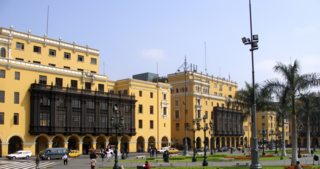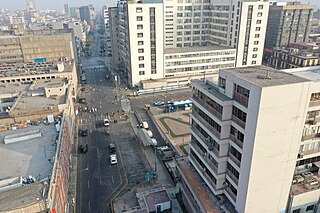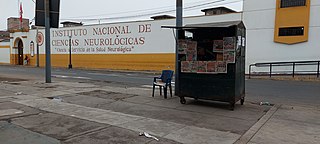
The Basilica Cathedral of Lima, commonly known as the Metropolitan Cathedral of Lima, is a Roman Catholic cathedral in Lima, Peru. It is the seat of the Archdiocese of Lima. Its construction began in 1535 and finished in 1797, having been built in its present form between 1602 and 1797. Its patron saint is Saint John, Apostle and Evangelist, to whom it is dedicated.

The Monastery of Santo Toribio de Liébana is a Roman Catholic monastery located in the district of Liébana, near Potes in Cantabria, Spain. Located in the Cantabrian Mountains in northern Spain, the monastery is one of the five places in Roman Catholicism, together with Rome, Jerusalem, Santiago de Compostela and Caravaca de la Cruz, that has the privilege of issuing perpetual indulgences.

Toribio Alfonso de Mogrovejo was a Spanish Catholic prelate who served as Archbishop of Lima from 1579 until his death.
Turibius or Toribius is the name of several saints:

Saint Turibius of Astorga was an archdeacon of Tui and an early Bishop of Astorga. Turibius was a zealous maintainer of ecclesiastical discipline, and defender of the Nicene Christianity against the Galician heresy of Priscillianism, for which he received a supportive letter from Leo the Great, which still survives.

The Royal and Conciliar San Carlos Seminary is the archdiocesan seminary of the Archdiocese of Manila. It was established in the year 1702, by decree of King Philip V of Spain. At present, the institution houses seminarians belonging to various dioceses in Luzon, particularly from the Metro Manila region.

Jirón Áncash is a major street in the Damero de Pizarro, located in the historic centre of Lima, Peru. The street starts at its intersection with the Jirón de la Unión at the Puente de Piedra, and continues until it reaches the Óvalo de la Paz.

Jirón Callao is a major street in the Damero de Pizarro, located in the historic centre of Lima, Peru. The street starts at its intersection with the Jirón Sancho de Rivera and continues until it reaches the Jirón de la Unión, next to the Plaza de Armas.

Jirón Conde de Superunda, formerly Jirón Lima, is a major street in the Damero de Pizarro, located in the historic centre of Lima, Peru. The street starts at its intersection with the Jirón de la Unión, next to the Palacio Municipal de Lima, and continues until it reaches the Jirón Cañete.

Jirón Huallaga is a major street in the Damero de Pizarro, located in the historic centre of Lima, Peru. The street starts at its intersection with the Jirón de la Unión at the Plaza Mayor and continues until it reaches Jirón Cangallo in Barrios Altos, about a block after it passes through the Plaza Italia.

Jirón Cuzco is a major street in the Damero de Pizarro, located in the historic centre of Lima, Peru. The street starts at its intersection with the Jirón de la Unión and continues until it reaches Jirón Huánuco in Barrios Altos.

Jirón Huancavelica is a major street in the Damero de Pizarro, located in the historic centre of Lima, Peru. The street starts at its intersection with the Jirón de la Unión and continues until it reaches Jirón Ramón Cárcano.

Jirón Junín is a major street in the Damero de Pizarro, located in the historic centre of Lima, Peru. The street starts at its intersection with the Jirón de la Unión and continues for 19 blocks until it reaches Nicolás Ayllón Avenue.

Jirón Lampa is a major street in the Damero de Pizarro, located in the historic centre of Lima, Peru. The street starts at its intersection with the Jirón de la Unión and continues until it reaches the Paseo de la República.

Jirón Santa Rosa, known as Jirón Antonio Miró Quesada and as Jirón Ayacucho before that, is a major street in the Damero de Pizarro, located in the historic centre of Lima, Peru. The street starts at its intersection with the Jirón de la Unión and continues until it reaches Miguel Grau Avenue.

The Church and Convent of Our Lady of Peñafrancia, better known as St. Clare's Monastery, is a Catholic church, convent and monastery belonging to the Capuchin Poor Clares located in the neighbourhood of Barrios Altos, part of the historic centre of Lima, Peru.

Jirón Caylloma, also known as Jirón Cailloma, is a major street in the Damero de Pizarro, located in the historic centre of Lima, Peru. The street starts at its intersection with Jirón Conde de Superunda and continues until it reaches Jirón Quilca.

Jirón Rufino Torrico, formerly known as Jirón Arica, is a major street in the Damero de Pizarro, located in the historic centre of Lima, Peru. The street starts before its intersection with the Jirón Conde de Superunda, parallel to the Prolongación Tacna, and continues until it reaches Inca Garcilaso de la Vega Avenue.

The "Óscar Trelles Montes" National Institute of Neurological Sciences, also known by its former names Saint Turibius of Mogrovejo Hospital and Hospital for Incurables, is a public specialised hospital centre administered by the Ministry of Health of Peru. It is dedicated to specialised care in neurology, neurosciences and neurosurgery; and is also dedicated to research and teaching. Founded in the viceregal era with a Royal Decree of August 26, 1700, as the Refuge for Incurables on Maravillas Street. It is located in the neighbourhood of Barrios Altos, part of Lima District.

Pedro Manuel García Naranjo was a Peruvian Catholic priest who served as the 26th Archbishop of Lima from 1908 to 1917. As an educator, he placed special emphasis on improving priesthood education provided at the Seminary of Lima. Under his episcopate, the Pontifical Catholic University of Peru was founded in 1917.




















